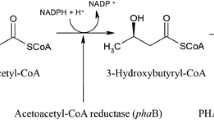Abstract
Burkholderia sp. IS-01 capable of biosynthesizing poly(3-hydroxybutyrate-co-3-hydroxyvalerate) [poly(3HB-co-3HV)] copolyesters with a high molar fraction of 3HV was isolated from the gut of the adult longicorn beetle, Moechotypa diphysis. The strain IS-01 was relatively tolerant to high concentrations of levulinic acid and accumulated a poly(13.5 mol% 3HB-co-86.5 mol% 3HV) copolyester when cultivated on a mixture of gluconate (20 g/L) and levulinic acid (12.5 g/L). In this case, the content of the copolyester in the cells was approximately 60.0%. The compositions of the copolyesters were easily regulated by altering the molar ratio of gluconate and levulinic acid in the medium. The organism was found to possess a class I PHA synthase (PhaC) gene (1,881 bp) that encodes a protein with a deduced molecular mass of 68,538 Da that consists of 626 amino acids. The PhaC of this organism was most similar to that of B. cenocepacia PC184 (92% similarity).
Similar content being viewed by others
References
Alias, Z. and I.K.P. Tan. 2005. Isolation of palm oil-utilizing, polyhydroxyalkanoate (PHA)-producing bacteria by an enrichment technique. Bioresour. Technol. 96, 1229–1234.
Brune, A. 1998. Termite guts: the world’s smallest bioreactors. Trends Biotechnol. 16, 16–21.
Cha, J.Y. and M.A. Hanna. 2002. Levulinic acid production based on extrusion and pressurized batch reaction. Ind. Crops Prod. 16, 109–118.
Choi, G.G., M.W. Kim, J.Y. Kim, and Y.H. Rhee. 2003. Production of poly(3-hydroxybutyrate-co-3-hydroxyvalerate) with high molar fractions of 3-hydroxyvalerate by a threonine-overproducing mutant of Alcaligenes sp. SH-69. Biotechnol. Lett. 25, 665–670.
Chung, S.H., G.G. Choi, H.W. Kim, and Y.H. Rhee. 2001. Effect of levulinic acid on the production of poly(3-hydroxybutyrate-co-3-hydroxyvalerate) by Ralstonia eutropha KHB-8862. J. Microbiol. 39, 79–82.
Hang, X., G. Zhang, G. Wang, X. Zaho, and G.Q. Chen. 2002. PCR cloning of polyhydroxyalkanoate biosynthesis genes from Burkholderia caryophylli and their functional expression in recombinant Escherichia coli. FEMS Microbiol. Lett. 210, 49–54.
Keenan, T.M., S.W. Tanenbaum, A.J. Stipanovic, and J.P. Nakas. 2004. Production and characterization of poly-β-hydroxyalkanoate copolymers from Burkholderia cepacia utilizing xylose and levulinic acid. Biotechnol. Prog. 20, 1697–1704.
Kim, D.Y., H.W. Kim, M.G. Chung, and Y.H. Rhee. 2007. Biosynthesis, modification, and biodegradation of bacterial medium-chain-length polyhydroxyalkanoates. J. Microbiol. 45, 87–97.
Kim, H.J., D.Y. Kim, J.S. Nam, K.S. Bae, and Y.H. Rhee. 2003. Characterization of an extracellular medium-chain-length poly (3-hydroxyalkanoate) depolymerase from Streptomyces sp. KJ-72. Antonie Van Leewenhoek 83, 183–189.
Kim, D.Y., Y.B. Kim, and Y.H. Rhee. 1998. Bacterial poly(3-hydroxyalkanoates) bearing carbon-carbon triple bonds. Macromolecules 31, 4760–4763.
Kim, D.Y., Y.B. Kim, and Y.H. Rhee. 2000. Evaluation of various carbon substrates for the biosynthesis of polyhydroxyalkanoates bearing functional groups by Pseudomonas putida. Int. J. Biol. Macromol. 28, 23–29.
Park, D.S., H.W. Oh, W.J. Jeong, H. Kim, H.Y. Park, and K.S. Bae. 2007. A culture based study of the bacterial communities within the guts of nine longicorn beetle species and their exoenzyme producing properties for degrading xylan and pectin. J. Microbiol. 45, 394–401.
Park, S.K., K.T. Lee, Y.B. Kim, and Y.H. Rhee. 1997. Biosynthesis of polyhydroxybutyrate and poly(3-hydroxybutyrate-co-3-hydroxyvalerate) by Bacillus thuringiensis R-510. J. Microbiol. 35, 127–133.
Rodrigues, M.F.A., H.E. Valentin, P.A. Berger, M. Tran, J. Asrar, K.J. Gruys, and A. Steinbüchel. 2000a. Polyhydroxyalkanoate accumulation in Burkholderia sp.: a molecular approach to elucidate the genes involved in the formation of two homopolymers consisting of short-chain-length 3-hydroxyalkanoic acids. Appl. Microbiol. Biotechnol. 53, 453–460.
Rodrigues, M.F.A., E.J. Vicente, and A. Steinbüchel. 2000b. Studies on polyhydroxyalkanoate (PHA) accumulation in a PHA synthase I-negative mutant of Burkholderia cepacia generated by homogenotization. FEMS Microbiol. Lett. 193, 179–185.
Savenkova, L., Z. Gercberga, I. Bibers, and M. Kalnin. 2000. Effect of 3-hydroxyvalerate content on some physical and mechanical properties of polyhydroxyalkanoates produced by Azotobacter chroococum. Proc. Biochem. 36, 445–450.
Steinbüchel, A. and T. Lütke-Eversloh. 2003. Metabolic engineering and pathway construction for biotechnological production of relevant polyhydroxyalkanoates in microorganisms. Biochem. Eng. J. 16, 81–96.
Author information
Authors and Affiliations
Corresponding author
Rights and permissions
About this article
Cite this article
Kim, D.Y., Park, DS., Kwon, S.B. et al. Biosynthesis of poly(3-hydroxybutyrate-co-3-hydroxyvalerate) copolyesters with a high molar fraction of 3-hydroxyvalerate by an insect-symbiotic Burkholderia sp. IS-01. J Microbiol. 47, 651–656 (2009). https://doi.org/10.1007/s12275-009-0109-7
Received:
Accepted:
Published:
Issue Date:
DOI: https://doi.org/10.1007/s12275-009-0109-7




